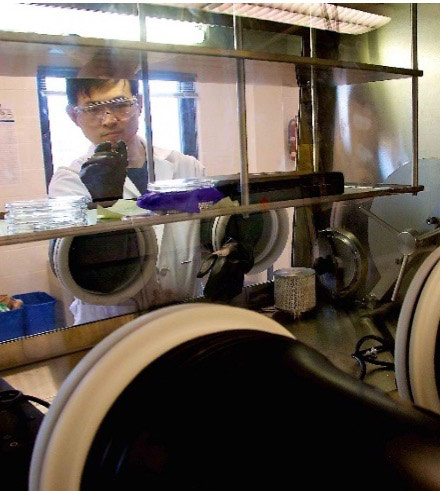
For the past decade, the Materials for Opto/Electronics Research and Education (MORE) Center has provided the Case Western Reserve University community with the tools and expertise needed to make and measure materials and devices used for electronic and optoelectronic applications. In recognition of its 10-year anniversary, celebrated in July, we took a look at the center’s resources and how its experts have supported researchers at the university and beyond over the years.
At its core, the center serves as a research space for dozens of researchers who log thousands of hours of time each year using 20 instruments, including:
- inert glove boxes (sealed containers used to manipulate materials where a separate atmosphere is desired)
- a clean room (a controlled environment where pollutants like dust, airborne microbes, and aerosol particles are filtered out in order to provide the cleanest area possible)
- profilometers (a measuring instrument used to measure a surface’s profile, in order to quantify its roughness)
“We are effectively a giant toolbox,” said Ina Martin, the MORE Center’s director of operations. “But, [we have] experts who will train your students and help you with your research.”
Students and faculty from Case Western Reserve and other universities in the area rely on the MORE Center to conduct their research, as do companies ranging from startups to international conglomerates. And recently, the MORE Center played a key role in one interdisciplinary team’s efforts to win a Think Big Leadership Award; the team is working to combine physics, art history and machine learning in their quest to help art historians correctly identify artists.
“The MORE Center is a laboratory where researchers from different departments can work side by side to learn skills that are directly applicable to industry and research careers,” Michael McMaster, a recent physics PhD graduate who worked on the project, said.
Physicists, art historians and machine learning specialists, in conjunction with the Cleveland Institute of Art and the Cleveland Museum of Art, used a newer tool—an optical profilometer—in their Transforming Art History project. An optical profilometer measures the surface height of relatively flat objects quickly and is able to accurately measure a large area. In this case, the team was using the optical profilometer on paintings to identify an artist by their style using the surface height information collected.
“The MORE Center facilitates camaraderie and friendship among scientists who are often siloed in their respective departments or even laboratories,” McMaster said. “It is more than a collection of scientific tools, it is a center for building skills and community.”
Heather Mirletz (CWR ‘12, MSE ‘13) was the first undergraduate student to get training and work in the MORE Center when it opened 10 years ago. Hand-in-hand with Martin, Mirletz, a third-year student at the time, helped set up the center, learned the equipment and eventually, accomplished many projects of her own, specifically studying the deposition and degradation of transparent conductive oxides (TCOs). This research tackled how to extend the lifetime of a material that is used in everything from smart phones to solar panels, and resulted in multiple conference presentations, proceedings and a journal article. As she explored the center and started learning new, technical skills, Mirletz’ interest in chemical engineering, her major, started to shift toward material sciences.
“[The MORE Center] allowed me to really engage deeply with solar technology, which has really been my passion,” she said. “At the center, I engaged with [solar technology] deeply, at a technical level and it cast my career in that direction.”
Founder and faculty director, Ken Singer, said there are many amazing things that have come out of the MORE Center since its inception, but it boils down to two: the enthusiasm of the students to work and learn there and the ability to make an expensive research facility widely available to people across campus and the community.
Martin says her favorite part is watching the students grow: “Watching students going from never having taken a sample, to making a full solar cell—I love seeing that.”
For more stories about student researchers at the MORE Center check out their Instagram account at @cwru_morecenter.
To use the MORE Center, students, faculty and community members can register to be a user in iLab and after training, can be scheduled for a time slot. For more information, contact Ina Martin.
